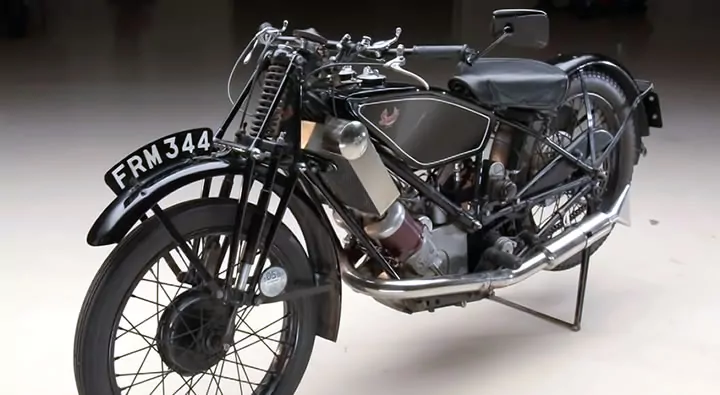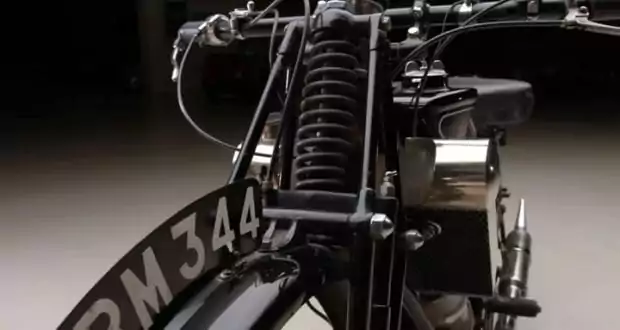Earlier this month on Jay Leno’s Garage (Jay Leno’s YouTube channel), Jay talked about his personal 1929 Scott Flying Squirrel.
The Scott was at the forefront in two-stroke motorcycles, with the first one being launched in 1926. Jay’s in particular was called a replica TT model because in 1929 Scott came in third in the Isle of Man TT and they got so much publicity that they decided to build a replica of that race bike.
Back in 1929, the bike cost roughly twice what a four-stroke counterpart may have cost, and while most motorcycles were air cooled in that time, this bike was liquid cooled. The liquid cooling didn’t use a water pump, it uses thermo-syphoning, which takes advantage of the engine’s heat to keep pushing water (just water, not coolant) through. Fun fact: Ford’s Model T uses thermo-syphoning as well. In the video, Jay takes it out in 100 degree Fahrenheit weather and it doesn’t overheat.


The race models of the Scott Flying Squirrel had barrels painted red, this was specific to the race models. The street models had green painted barrels. Jay’s bike is also the first year of the long stroke engine, and the two stroke engine was what Jay calls “a bit of a dark art at that time.”
The bike has separate oil and gas tanks, however Jay recommends keeping a touch of two stroke oil in the gas just to make sure that the Flying Squirrel is staying well lubricated.
He had no comments on the three-speed gearbox other than it had a hand shift. However, he did point out that the engine was designed to have opening to allow easy access to the bottom end of the engine through little compartment doors. Pretty cool and forward-thinking. I like it.

Given that this is a race model version of the bike, it did not come equipped with a headlight, and at the time, a motorcycle without a headlight could still be plated and put on the road. Jay says it feels like riding a two stroke from the 1960s, and while it’s a 500cc, it feels about on par with a 250cc from the 1960s as well.
The motorcycle was developed by Alfred Scott who Jay believes is credited for inventing the kick-starter as well as possibly the twist-grip throttle.
Being a race spec bike, the front drum brake was actually fairly effective, and it comes with a steering dampener. No idea how will that works compared to modern standards, but still kinda neat. It goes almost 100 miles per hour too, not bad at all for a 1929 500cc motorcycle. I mean, it’s ninety years later, and Harley-Davidson’s Street 500 doesn’t even go that fast.
 YouMotorcycle Motorcycle Blog – Motorcycle Lifestyle Blog, MotoVlog, Motorcycle Reviews, News, & How-Tos
YouMotorcycle Motorcycle Blog – Motorcycle Lifestyle Blog, MotoVlog, Motorcycle Reviews, News, & How-Tos


Hi Adrian, Jay Leno’s YouTube article was very interesting, but I remember that it contained a number of inaccuracies, perhaps the most glaring of which is his statement that Alfred Scott was a Scotsman! He was in fact an Englishman, from the county of Yorkshire, and this is where he set up manufacture of his motorcycles. The first Scott didn’t date from 1926; the water cooled two stroke twins were first produced in 1908, and Scotts won two Isle of Man TT races before the First World War. 1926 was the year of introduction of the Flying Squirrel model. The TT Replica was introduced after Tommy Hatch came third in the 1928 Senior TT, not 1929, and catalogues of that time list this as a distinct model, not a Flying Squirrel, which was used for the short stroke touring models. Scott didn’t invent the twist grip, although they did have a kick start when other motorcycles were started with bicycle pedals or by push starting Other motorcycles of the time were generally crude by comparison, with bicycle-type frames, no clutch, only one gear and belt drive. Scotts, with their smooth engines, water cooling, triangulated frames, telescopic forks, kickstart, two gears and chain drive were really refined and advanced. compared to the opposition. Some of their early machines even had disc valves. The assertion that the cylinders of race bikes were red and street bikes green is wrong. I’ve seen it suggested that (some?) works racing machines may have had green painted cylinders, but the models on sale to the general public had a deep red finish, produced by polishing the iron barrels, nickel plating them, and then painting them with a translucent dark red varnish. I suspect that the factory later changed the finish to red enamel as a cost-cutting exercise. At that time, lighting was often an extra-cost option, and it wasn’t a legal requirement to have lights fitted if the machine was only used during daylight hours. This is still the case. It also wasn’t a legal requirement to have a speedometer, and again, Scott offered these as an extra-cost option. My 1930 Flying Squirrel de Luxe left the factory in March 1930 with lights and a Bonniksen speedometer, but only because the original owner paid the extra over catalogue price. All of the Scott catalogue illustrations of the time show the bikes without lights or speedometer. I don’t wish to detract from Jay Leno’s interesting and entertaining presentation, but I think that it’s important to ensure that what is being stated as historical fact is actually correct.
Neil this comment is awesome. I opened up my 1979 The World Of Motorcycles An Illustrated Encyclopedia volume 13 as a source to back check against your claims, let’s see what it says…
Tell you what, I’m starting to think I don’t need to fact-check the rest of your work haha. Thanks for pointing out this info. I’m going to continue picking through it. I’m also going to send you an email with some other Scott related material you might enjoy. Thanks for such a detailed comment that I’ll read as I sip on an after-dinner drink, this was great. Ride safe!
I’d be interested to know if this bike is wearing its original English registration number. That number would have originally been issued in Carlisle in Cumberland, as it was then.
The Scott was originally a relatively expensive motorcycle. In those days, Carlisle was not an affluent city and I suspect that there were not many Flying Squirrels registered there.
I was reliably informed by both my late father and my late uncle that my great uncle, William Irving of Carlisle, owned a Scott Flying Squirrel back in the day. If so, I think there’s a distinct possibilty that this bike was his machine.
I messaged Jay Leno’s Garage, in advance of a trip we made to California last year, to enquire if they had any information on the previous owners but heard nothing. If we’d established it was my late, great uncle’s bike, I’d have been keen to visit and see it in the metal.
What a small world!